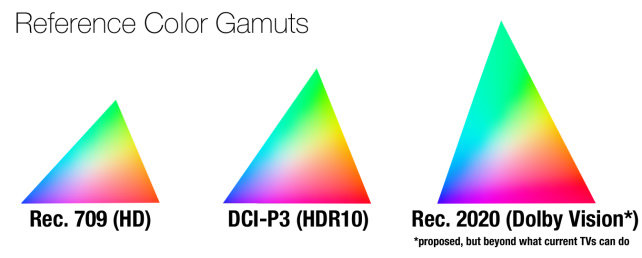HDR is the TV buzzword for 2017—here's what you need to know
High Dynamic Range (HDR) is the latest and greatest thing in TV tech. While it's available in a multitude of formats right now, the basic idea behind each is the same: deliver content to your TV that's much less compressed than ever before, enabling a wider color palette and higher dynamic range, all in 4K resolution.
An easy way to describe High Dynamic Range is via the phrase "better pixels." This refers to the combination of higher resolution, better contrast, more color, and faster frame rates.
This image from Dolby provides a pretty concise formula for what High Dynamic Range "is," where pixels are concerned.
And as we and many other TV journalists have reported, there isn't really a format war at play here. But it's still worth knowing what you're getting access to when you buy a new TV. Here's a breakdown of the HDR formats as they stand right now.
HDR10
The HDR format known as "HDR10" is the most wide-spread and easy-to-implement HDR format. It's an open-source format that any manufacturer can implement into a television without paying a licensing fee, and allows the TV to interpret and display HDR10 content.
Currently, all HDR Blu-ray discs are technically HDR10 discs. You can also get HDR10 content on apps like Netflix and Amazon Instant. Where HDR10 differs from another format, like Dolby Vision, is in terms of how the content is mastered before the TV receives and displays it. For example, HDR10 has easier to hit color standards than Dolby Vision.
Here's a LOT more information on the differences between HDR10 and Dolby Vision.

Dolby Vision
The other major HDR format, Dolby Vision (which is essentially the video answer to Dolby's "Atmos" sound systems) is a proprietary format that's mastered at much higher standards than HDR10. In a way, this makes it a higher-quality format than HDR10—but there are also no displays that can match Dolby Vision's high standards, so it's easy to argue about diminishing returns.
Because it's a closed, proprietary system and is essentially more expensive to adopt, Dolby Vision is not as widespread as HDR10. A huge majority of the TVs on the market billed as "HDR" are HDR10-compatible TVs. If a TV has Dolby Vision, it will usually say so.
Currently, you can get Dolby Vision content on apps like Netflix and VUDU. There aren't any Dolby Vision discs yet, but Dolby has said they'll be coming very soon, alongside Dolby Vision-enabled disc players. All LG OLEDs are both Dolby Vision and HDR10 compliant, and most of Vizio's 2017 lineup, too.
Hybrid-Log Gamma
That's a mouthful, huh? Hybrid-Log Gamma (HLG) is another HDR format, albeit one that exists specifically for broadcast (cable/satellite) purposes. While we'd argue that HDR10 and Dolby Vision are not in competition, there's definitely no need to choose between either one and HLG.
HLG serves to present content with sets of metadata that allow video producers and content distributors to present a single stream of content data that displays properly in both "standard" dynamic range and high dynamic range—or, on both HDR and non-HDR TVs. It's a standard developed by both the BBC and NHK, and despite being adopted by some high-end TVs this year, is unlikely to become a huge selling factor where potential buyers are concerned.
Technicolor HDR
Technicolor HDR is an HDR format that exists pretty much solely in Europe right now, but its main purpose is to move away from the digital-only encoding (EOTF) that other HDR formats use, allowing for HDR to be set to traditional gamma curves, for example, allowing for playback of HDR content on SDR devices.
You might argue whether HDR is defined by the format or by the specifications of the display showing it. For example, if I were to play Technicolor HDR content on an old CRT, would it be HDR just because it was encoded that way, even with so much brightness and color sacrificed? But that's beside the point.
What do I absolutely need to know?
As it stands, the major players in HDR this year are still HDR10 and Dolby Vision, and they so-far seem to be co-existing without trouble. While it couldn't hurt to get a TV that's HLG compatible just in-case HDR broadcasts come along this year, it's not very likely, either.
So if you want the most HDR content right now, your best bet is to find a TV that is both HDR10 and Dolby Vision-compatible. Failing that, HDR10 is the more widely adopted standard of the moment, but Dolby Vision could prove to be the higher-quality standard down the line if you're planning on keeping your next TV for more than a few years.



